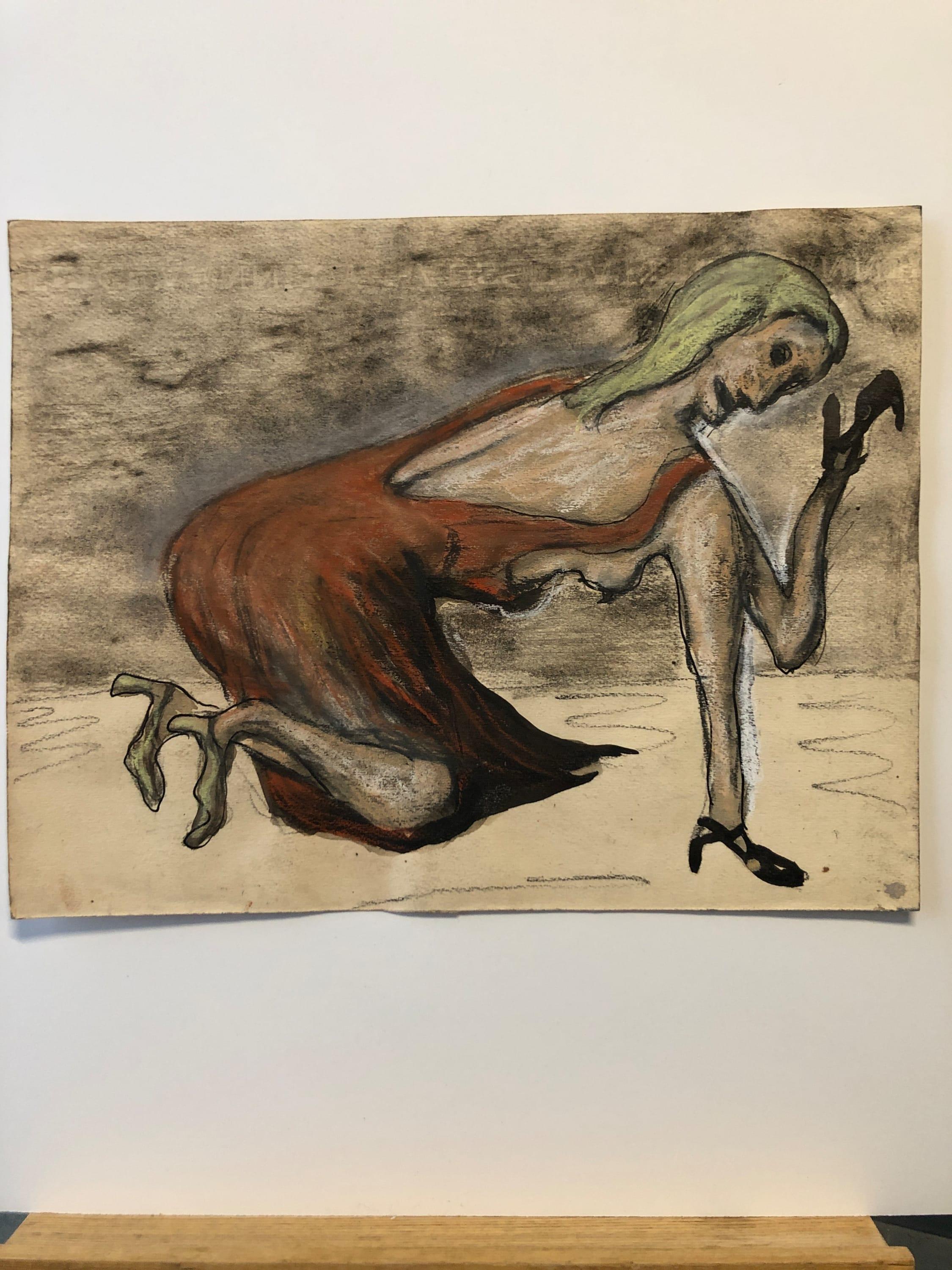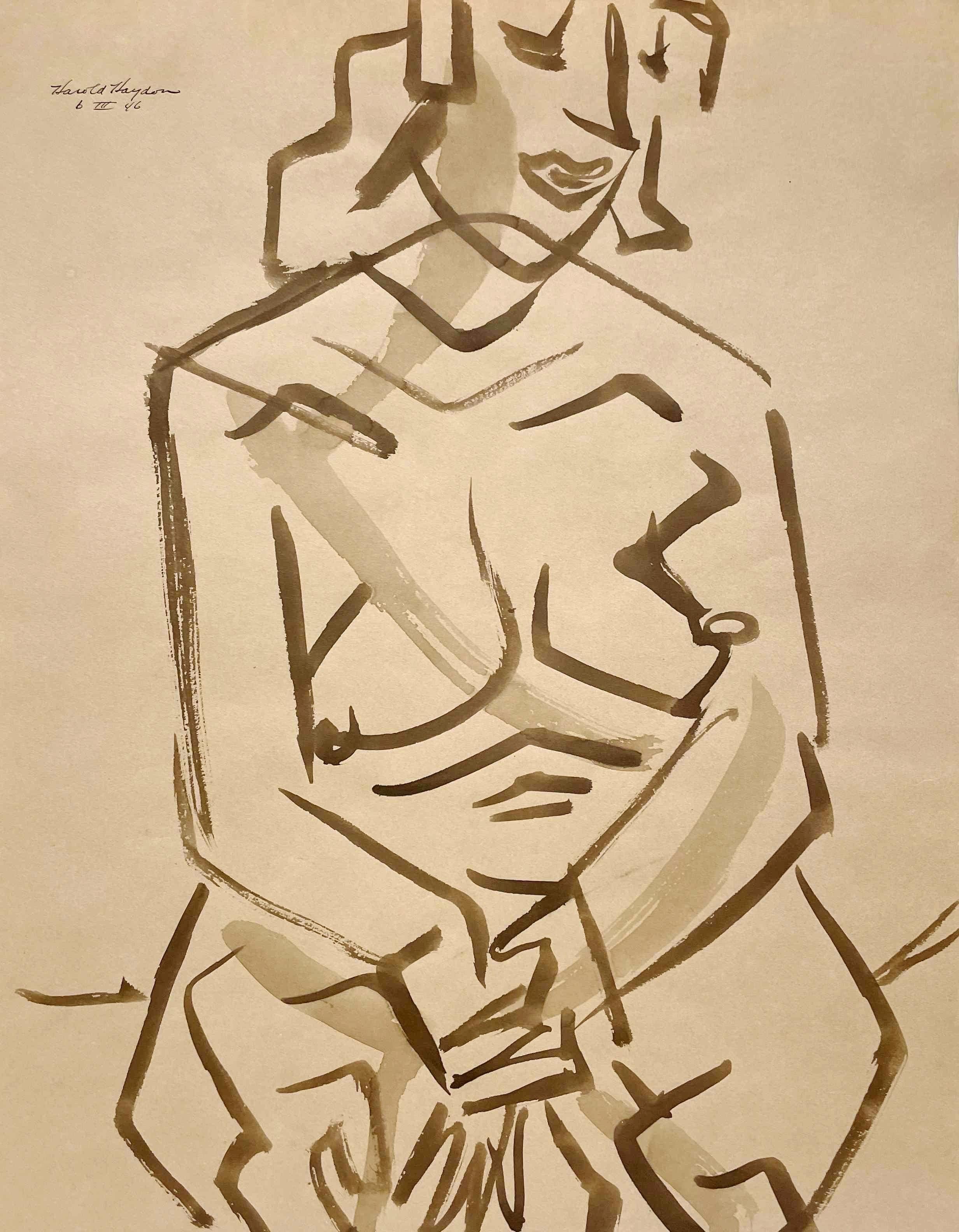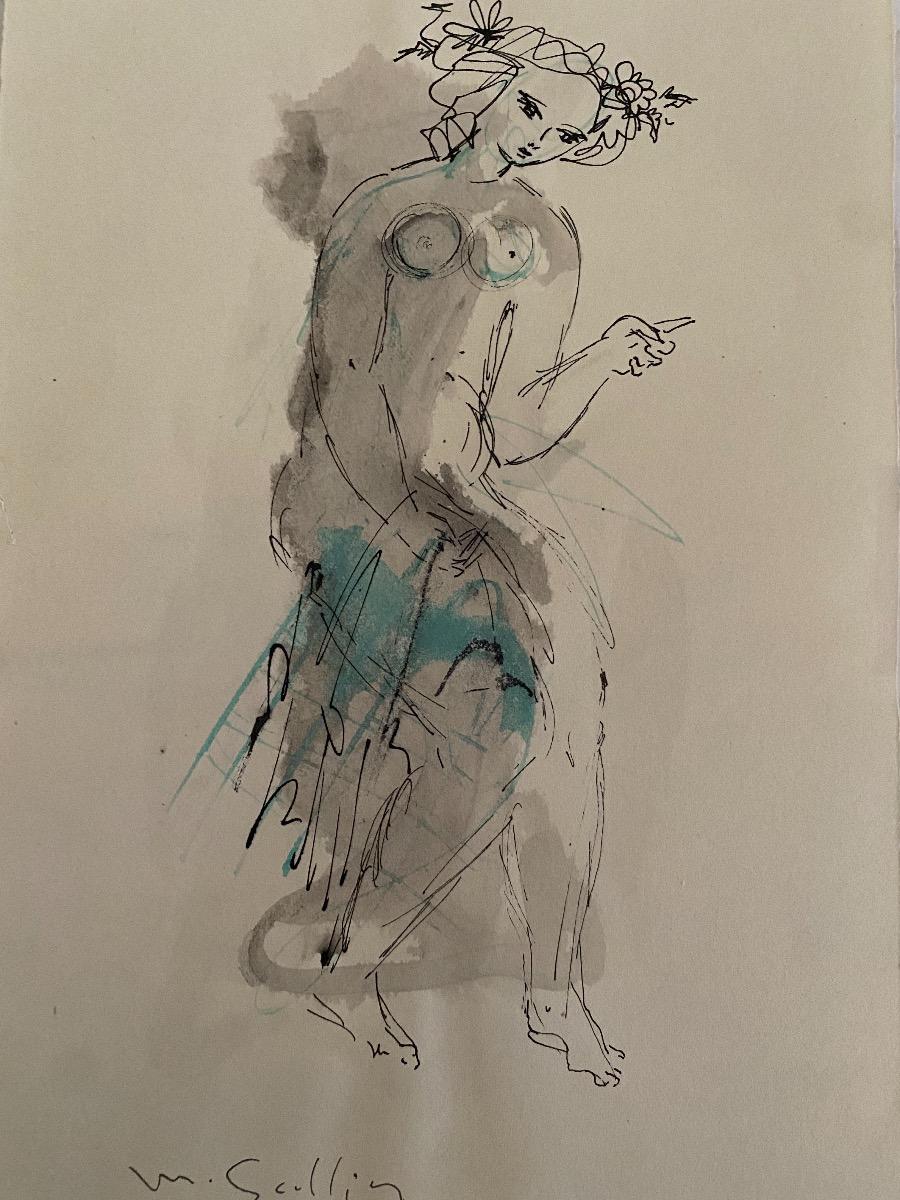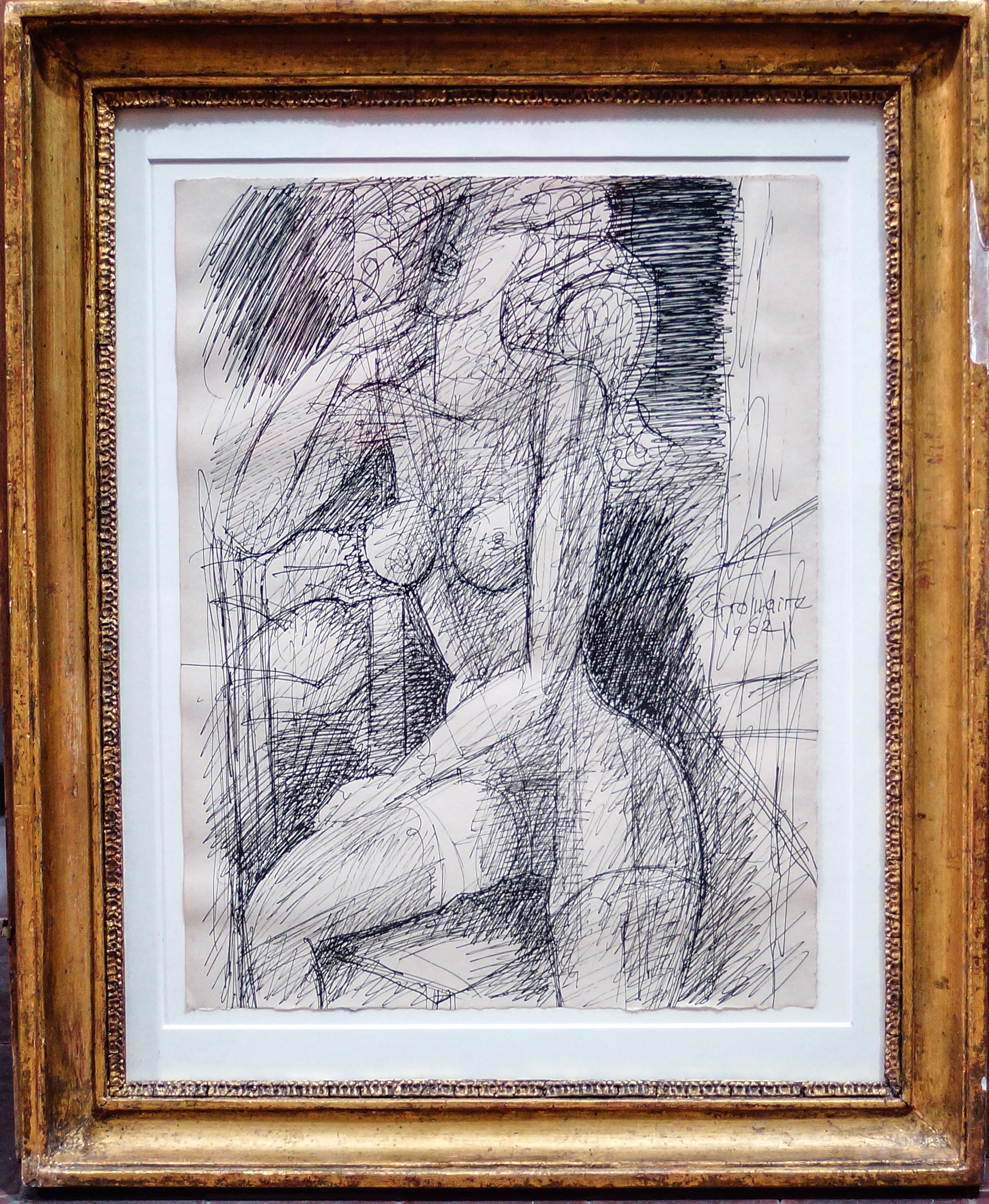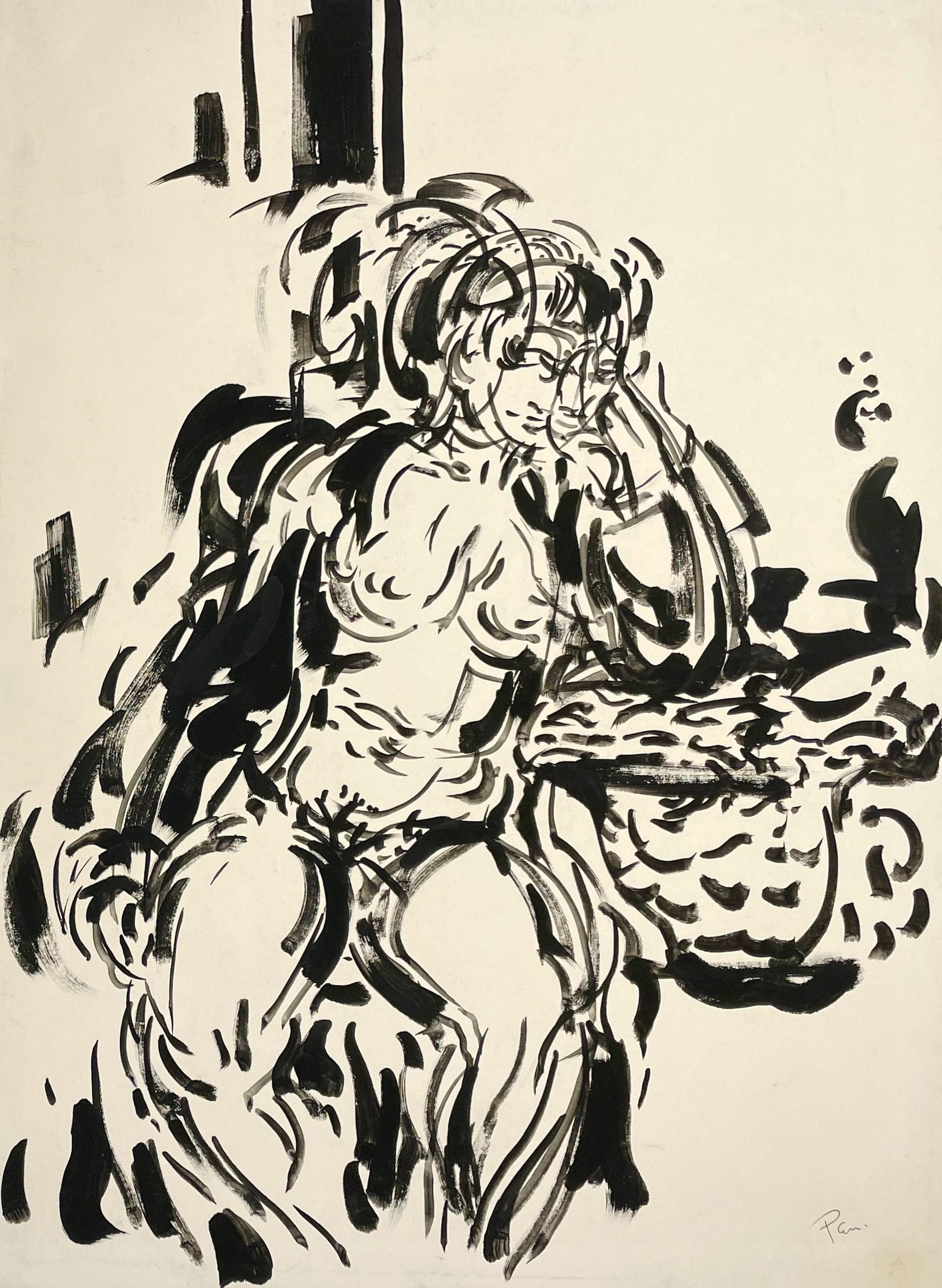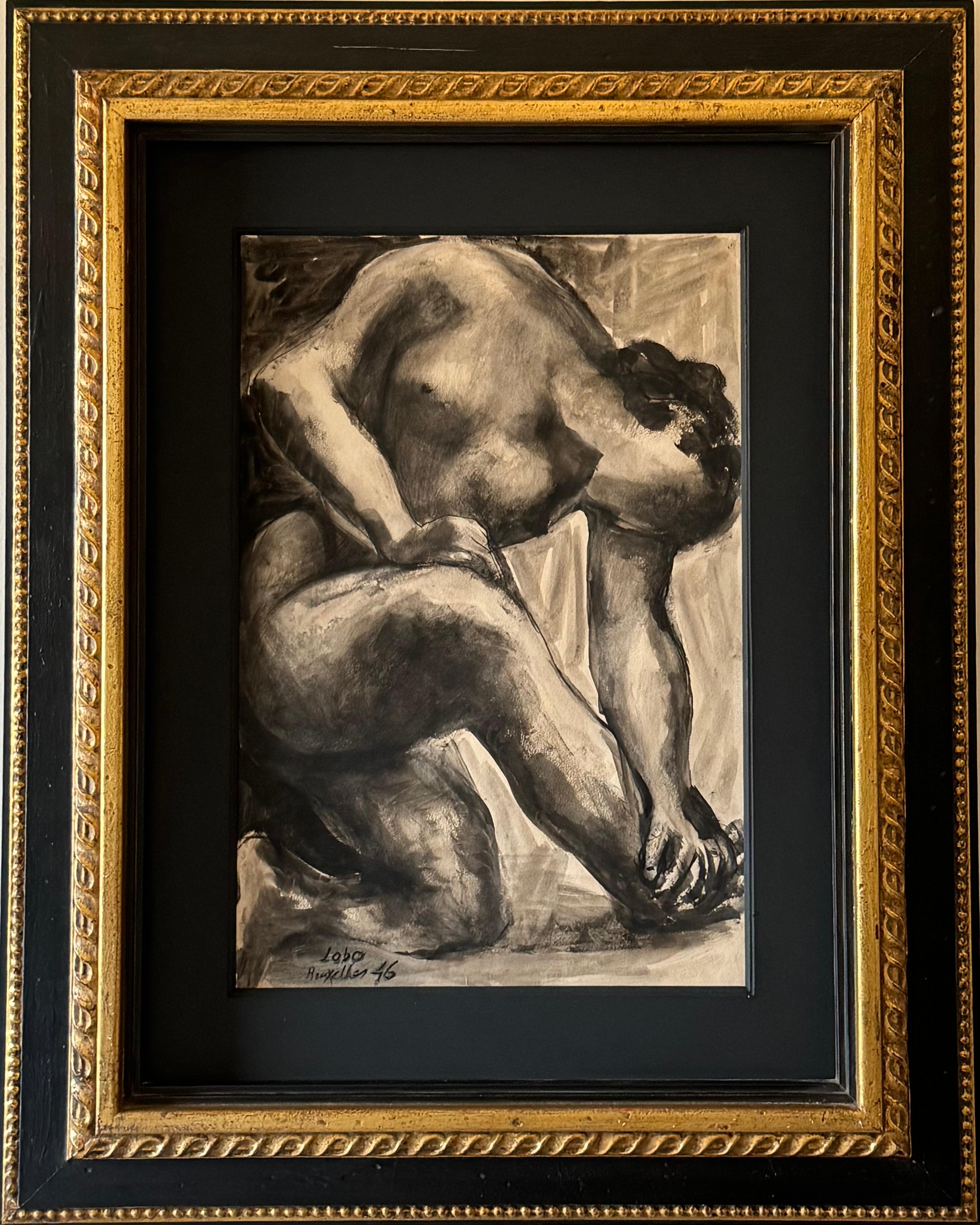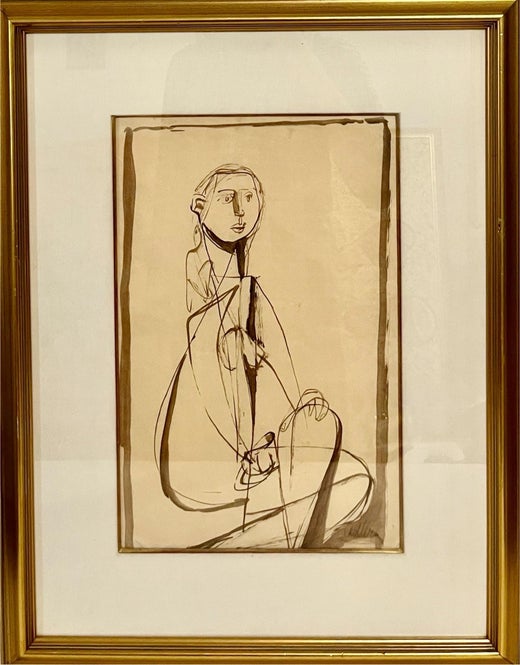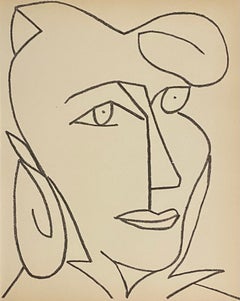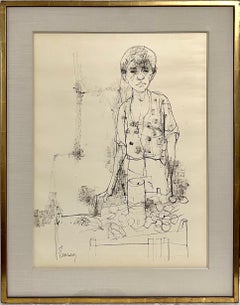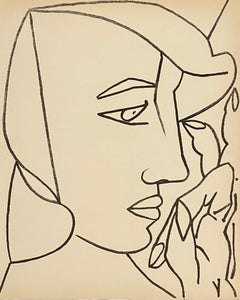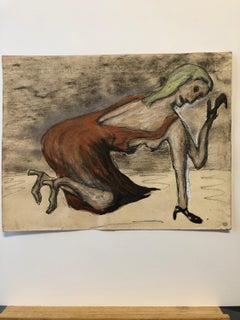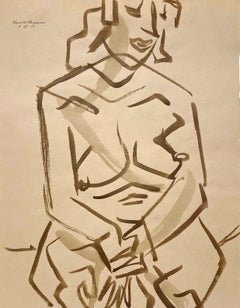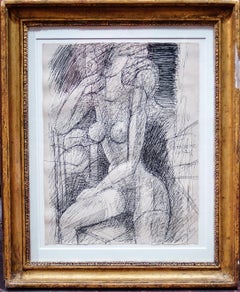Items Similar to Modernist Ink and Wash Drawing, Painting Jankel Adler Woman Model Ecole De Paris
Want more images or videos?
Request additional images or videos from the seller
1 of 11
Jankel AdlerModernist Ink and Wash Drawing, Painting Jankel Adler Woman Model Ecole De Parisc.1930's-1940's
c.1930's-1940's
$4,500
£3,461.70
�€4,018.05
CA$6,346.07
A$7,108.67
CHF 3,733.73
MX$86,439.15
NOK 47,281.22
SEK 44,882.59
DKK 29,988.26
About the Item
Jankel Adler (Polish, 1895–1949)
'Seated Nude'
Watercolor in sepia tones on paper,
Hand signed
Dimensions: Framed 26 x 20 inches, sheet 17.88 x 14.75 inches
Provenance: Bears a label verso from A.M. Adler Fine Arts NYC
Jankel Adler (born Jankiel Jakub Adler, 1895 – 1949) was a Polish-Jewish avant-garde painter and printmaker active primarily in Germany, France and England. He began his career as an engraver in Belgrade before studying arts in Germany. Co-founding the Yung-yidish group in Łódź (Lodz, Poland), he later became involved with the Cologne Progressives and the Union of Progressive International Artists in Germany. He began teaching at Kunstakademie Düsseldorf and was a student of the Swiss abstract expressionist painter Paul Klee who had an important influence on Adler's work. Facing Nazi persecution, Adler fled to Paris in 1933, where he actively opposed fascism. His works were targeted by the Nazis, with several displayed in the Degenerate Art Exhibition. Adler volunteered for the Polish army during World War II but was later discharged for health reasons, eventually settling in Scotland and then Aldbourne, England. He later discovered that none of his siblings survived the Holocaust. Adler died in Aldbourne in 1949.
Yankel Yaacov Adler was born as the seventh of ten children to an Orthodox Jewish family Tuszyn, a suburb of Łódź. In 1912 he began training as an engraver with his uncle in Belgrade. He moved in 1914 to Germany where he lived for a time with his sister in Barmen, (now part of Wuppertal). There he studied at the college of arts and crafts with professor Gustav Wiethücher. From 1918 to 1919 he went back to Łódź, where he was joint founder of Yung-yidish, a group of young Jewish artists. In 1920 he returned briefly to Berlin; in 1921 he returned to Barmen, and in 1922 he moved to Düsseldorf. In May 1922 he attended the International Congress of Progressive Artists and signed the "Founding Proclamation of the Union of Progressive International Artists". He also joined Franz Seiwert and Otto Freundlich in an artists group known as the Cologne Progressives. He became a teacher at the Academy of Arts, and became acquainted with, and influenced by the surrealism of Paul Klee and the expressionism of Otto Dix. A painting by Adler received a gold medal at the exhibition "German art Düsseldorf" in 1928. In 1929 and 1930 he went on study trips in Mallorca and other places in Spain. During the election campaign of July 1932 he published, with a group of leftist artists and intellectuals, an urgent appeal against the policy of the National Socialists and for communism. As a modern artist, and especially as a Jew, he faced persecution under Hitler's regime which took power in 1933. In that year, two of his pictures were displayed by the Nazis at the Mannheimer Arts Center as examples of degenerate art, and Adler left Germany, staying in Paris where he regarded his exile consciously as political resistance against the fascist regime in Germany.
Adler was affiliated with the art movement known as the School of Paris; together with other outstanding Jewish artists of that milieu, he is sometimes considered to be part of a group referred to specifically as the Jewish School of Paris. Includes painters Jankel Adler, Arbit Blatas, Marc Chagall, Jacques Chapiro, Michel Kikoine, Pinchus Kremegne, Sigmund Menkes, Jules Pascin, Issachar Ryback, Jacques Lipchitz, Chana Orloff, and Ossip Zadkine. Ecole de ParisIn the years that followed, he made numerous journeys to Poland, Italy, Yugoslavia, Czechoslovakia, Romania and the Soviet Union. He also spent time in Paris, working at Atelier 17 with Stanley William Hayter. In 1937, twenty-five of his works were seized from public collections by the Nazis and four were shown in the Degenerate Art Exhibition in Munich.
With the outbreak of World War II in 1939, he volunteered for the Polish army that had been reconstituted in France; in 1941 he was discharged for health reasons and lived thereafter in Kirkcudbright in Scotland where his work at this time included his Venus of Kirkcudbright. In 1943 he moved to London, Adler had a major impact on several younger, British artists, notably Robert Colquhoun and Robert MacBryde. Adler’s Jewish heritage was a great influence on his early work, but in the early 1930s he moved away from Expressionism to experiment with abstraction and surrealism. Around 1945 a wealthy patron, Jimmy Bomford, arranged for him to live at Aldbourne, Wiltshire. He later learned that none of his nine siblings in Poland had survived The Holocaust. Adler died in Whitley Cottage in Aldbourne on 25 April 1949 at the age of 53, and is buried at the Jewish cemetery in Bushey, Hertfordshire.
Adler was strongly influenced by Pablo Picasso and Fernand Léger. He enjoyed experimenting with materials, for example sand admixtures. He often painted Jewish subjects, and painted a few abstract compositions.Today, the artist’s works are held in the collections of the Tate Gallery in London, The Museum of Modern Art in New York, and the Museum Sztuki in Łódź, among others.
- Creator:Jankel Adler (1895 - 1949, British, Polish)
- Creation Year:c.1930's-1940's
- Dimensions:Height: 26 in (66.04 cm)Width: 20 in (50.8 cm)
- Medium:
- Movement & Style:
- Period:
- Condition:
- Gallery Location:Surfside, FL
- Reference Number:1stDibs: LU38214598362
Jankel Adler
Jankel Jakub Adler was born in Tuszyn, a suburb of Łódź. In 1912, he began training as an engraver with his uncle in Belgrade. He became a teacher at the Academy of Arts and became acquainted with Paul Klee, who influenced his work. A painting by Adler received a gold medal at the exhibition "German art Düsseldorf" in 1928. Adler was strongly influenced by Picasso and Léger. He enjoyed experimenting with materials, for example, sand admixtures. He often painted Jewish subjects and painted some abstract compositions.
About the Seller
4.9
Platinum Seller
Premium sellers with a 4.7+ rating and 24-hour response times
Established in 1995
1stDibs seller since 2014
1,786 sales on 1stDibs
Typical response time: <1 hour
- ShippingRetrieving quote...Shipping from: Surfside, FL
- Return Policy
Authenticity Guarantee
In the unlikely event there’s an issue with an item’s authenticity, contact us within 1 year for a full refund. DetailsMoney-Back Guarantee
If your item is not as described, is damaged in transit, or does not arrive, contact us within 7 days for a full refund. Details24-Hour Cancellation
You have a 24-hour grace period in which to reconsider your purchase, with no questions asked.Vetted Professional Sellers
Our world-class sellers must adhere to strict standards for service and quality, maintaining the integrity of our listings.Price-Match Guarantee
If you find that a seller listed the same item for a lower price elsewhere, we’ll match it.Trusted Global Delivery
Our best-in-class carrier network provides specialized shipping options worldwide, including custom delivery.More From This Seller
View AllPortrait Woman Original French Mourlot Modernist Lithograph 1951 Francoise Gilot
By Françoise Gilot
Located in Surfside, FL
Rare vintage limited edition Stone Lithograph printed at Mourlot in Paris. this is from a signed and numbered portfolio but the individual shee...
Category
1950s Modern Portrait Prints
Materials
Lithograph
Large Drawing of Boy by French Armenian Modernist Jean Jansem Ecole De Paris Art
By Jean Jansem
Located in Surfside, FL
Jean Jansem (Hovhannes Semerdjian) 1920-2013
Young Boy (sad young man)
Hand signed lower left corner
Provenance: Marble Arch Gallery NYC
Measurements Image size: 25 by 18 inches, ove...
Category
1960s Modern Figurative Drawings and Watercolors
Materials
Paper, Ink
Portrait Woman Original French Mourlot Modernist Lithograph 1951 Francoise Gilot
By Françoise Gilot
Located in Surfside, FL
Rare vintage limited edition Stone Lithograph printed at Mourlot in Paris. this is from a signed and numbered portfolio but the individual shee...
Category
1950s Modern Portrait Prints
Materials
Lithograph
Portrait Woman Original French Mourlot Modernist Lithograph 1951 Francoise Gilot
By Françoise Gilot
Located in Surfside, FL
Rare vintage limited edition Stone Lithograph printed at Mourlot in Paris. this is from a signed and numbered portfolio but the individual shee...
Category
1950s Modern Portrait Prints
Materials
Lithograph
Portrait of a Woman Original French Mourlot Modernist Lithograph Francoise Gilot
By Françoise Gilot
Located in Surfside, FL
Rare vintage limited edition Stone Lithograph printed at Mourlot in Paris. this is from a signed and numbered portfolio but the individual shee...
Category
1950s Modern Figurative Prints
Materials
Lithograph
Portrait of a Woman Original French Mourlot Modernist Lithograph Francoise Gilot
By Françoise Gilot
Located in Surfside, FL
Rare vintage limited edition Stone Lithograph printed at Mourlot in Paris. this is from a signed and numbered portfolio but the individual shee...
Category
1950s Modern Figurative Prints
Materials
Lithograph
You May Also Like
Mid Century Ink Wash Bizare Female Figure Original NYC Artist
Located in Arp, TX
Peter Passuntino
BDSM
1960s
Ink, ink wash & chalk on paper
12.25"x10" unframed
unsigned
Peter Passuntino
b. 1936
Peter Passuntino, was born in Chicago, Illinois. At the age of 18, Passuntino was selected to be in a group show at the Carnegie Institute, and at 19 he was selected for a one-man show at the Artist Guild in Chicago. From 1954 to 1958 he attended the School of the Art Institute of Chicago. Then, upon receiving a Fulbright Fellowship in Painting, Passuntino spent time in Paris, from 1963 to 1965. While in Paris he studied art at the Istitut de Arts et Archeologie and exhibited in a solo exhibition entitled “Bad Manners, A Happening at the American Arts Center” (1963). During his time at the School of the Art Institute of Chicago, Passuntino was an organizer of the Exhibition Momentum Group, and he served as the group’s chairman in 1958. The Exhibition Momentum Group was successful in expanding the Chicago-Midwest art community and in bringing emerging and established artists from the East Coast to Chicago as panelists and jurors of the exhibitions.
In 1969, The Rhino Horn Group was founded in New York City by a group of artists bound together by their dedication to figurative art and a collective notion that artistic practice should have both a critical and a social function. They critiqued the art-as-business ideology that absorbed fine arts into consumer culture in the United States during the 1960s.
The seven founding members were Peter Passuntino (b. 1936), Benny Andrews (1930-2006), Jay Milder (b. 1934), Peter Dean (1934-1993), Ken Bowman (1937-2014), Michael Fauerbach (1942-2011), and Nicholas Sperakis (b. 1943). Between 1969 and 1978, active members also included Bill Barrell (b. 1932), Leonel Góngora (1932-1999), Isser Aronovici (1932-1994), June Leaf...
Category
1960s Abstract Figurative Drawings and Watercolors
Materials
Paper, Chalk, Ink
A Fabulous 1940s Modern Cubist Watercolor of a Seated Female Nude, Sepia Toned
By Harold Haydon
Located in Chicago, IL
A Fabulous, 1940s Modern Cubist Watercolor of a Seated Female Nude Model by Noted Chicago Artist, Harold Haydon (Am. 1909-1994). Watercolor and ink on sepia toned paper, dating from...
Category
Mid-20th Century American Modern Nude Drawings and Watercolors
Materials
Paper, Ink, Watercolor
Figure - Original China Ink and Watercolor by Madeleine Scellier - 1955
By Madeleine Scellier
Located in Roma, IT
Figure is an original drawing in watercolored china ink on ivory-colored paper realized by the French artist Madeleine Scellier (1928).
Hand-signed in pencil on the lower margin.
T...
Category
1950s Modern Figurative Drawings and Watercolors
Materials
Paper, Ink
Female Figure - China Ink by Marcel Gromaire - 1962
By Marcel Gromaire
Located in Roma, IT
Beautiful China Ink drawing by Marcel Gromaire, 1962.
Contemporary wooden frame included.
Excelle conditions.
Category
1960s Nude Drawings and Watercolors
Materials
Ink
A Stunning Mid-Century Modern Ink Drawing of a Seated Female Nude by Rudolph Pen
Located in Chicago, IL
A Stunning Mid-Century Modern Ink Drawing of a Seated Female Nude by Noted Chicago Artist, Rudolph T. Pen. Completed in the 1960s, this compelling studio ink drawing is executed in ...
Category
Mid-20th Century American Modern Figurative Drawings and Watercolors
Materials
Paper, Ink
BALTASAR LOBO 1946 Seated Female Nude Abstract Figure Gouache & Ink on Paper
By Baltasar Lobo
Located in Rancho Santa Fe, CA
BALTASAR LOBO
Abstract Seated Nude Female Figure
1946
Gouache & Ink on Paper
Provenance: Ivan Boesky Collection, La Jolla, California
Signed & Dated "Lobo '46 Bruxelles"
Baltasar...
Category
1940s Abstract Figurative Paintings
Materials
Paper, Ink, Watercolor, Gouache
More Ways To Browse
Ink Paris
Ecole De Paris
Ecole De Paris Painting
German Expressionists Drawings
C M Young
1930s Modernist Painting
1940s French Drawings
German Paintings 1930s
Picasso 1930s
Degenerate Art
Paul Klee Exhibition
The Painter And His Model Picasso
Sepia Drawing
Vintage Paper Targets
Spanish Jewish
Picasso A Trip To Paris
Sepia Tone Paintings
National Socialist
